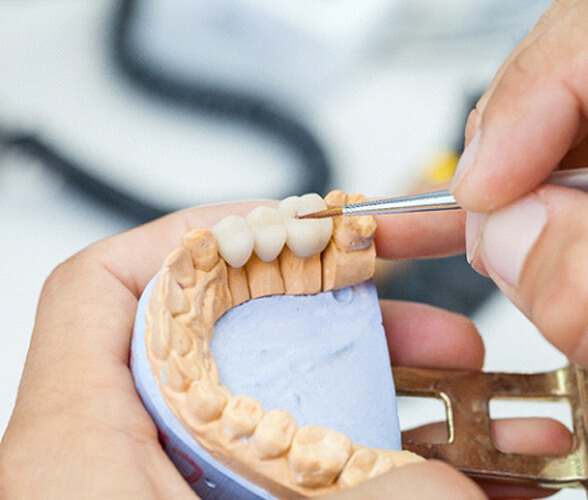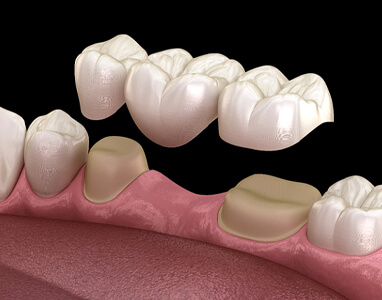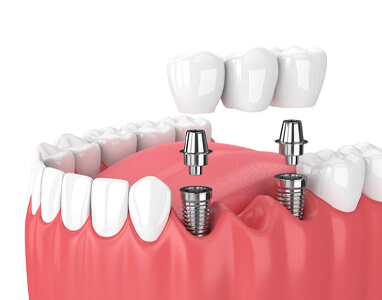Dental Bridges – Wauwatosa, WI
Enjoy a Complete, Fully Functioning Smile Once Again
Millions of Americans suffer from extensive tooth loss. If you have one or more consecutive gaps in your smile, you know firsthand just how much it can affect your quality of life. Luckily, you don’t have to live that way forever. At Wauwatosa Dental Arts, we offer a high-quality tooth-replacement solution known as dental bridges to replace your missing teeth. Not only can they improve your appearance, but they will help you eat and speak with complete confidence once again. To learn more about dental bridges in Wauwatosa, continue reading or schedule a consultation with one of our dentists today!
Why Choose Wauwatosa Dental Arts for Dental Bridges?
- Natural-Looking & Long-Lasting Results
- High-Quality, Durable, & Reliable Dental Restorations
- Insurance-Friendly Dental Practice
What is a Dental Bridge?

A dental bridge is a prosthetic that closes, or “bridges”, the gaps in your smile. It’s held in place by the abutment teeth on either side of the gap. The ideal candidate for a dental bridge is someone who has great oral and overall health, strong teeth free of decay, and missing one to four consecutive teeth. Although dental bridges can be made from a variety of materials, they’re often made from porcelain or ceramic for natural-looking results. Since those are color-matched to your tooth enamel, they’ll blend seamlessly with your remaining teeth once in place. No one will be able to tell you have a restoration!
Types of Dental Bridges

At your consultation, our team will conduct an oral examination to determine whether or not you’re eligible for a dental bridge. We’ll ask about your smile goals, review your medical and oral health history, and assess your unique needs to decide which treatment option is right for you. Based on our findings, we’ll recommend one of the following types of dental bridges:

Traditional Bridge
A traditional dental bridge is anchored to your mouth with crowns. It’s often used to replace one or more missing teeth that are right next to each other. With this option, your natural teeth will need to be altered to replace the missing ones.

Implant Bridge
Implant bridges are an excellent alternative that provides unmatched stability and durability. They’re secured to your mouth using two dental implants instead of dental crowns. Each titanium post is placed on either side of the gap in your smile. Once the implant has fused with the surrounding bone tissue via osseointegration, we’ll attach the dental bridge to the posts to complete your smile. What’s more, this treatment option requires no alteration of your natural teeth!
The Benefits of Dental Bridges

Many patients opt for dental bridges because they boast a wide range of benefits, including:
- Maintained alignment of your remaining teeth
- Improved oral health
- Jawbone preservation with implant bridges
- Long-lasting results (up to 15 years with traditional bridges and over 35 years with implant bridges)
- Natural-looking artificial teeth that blend seamlessly with existing teeth
- Lower maintenance and easy to care for
Dental Bridges FAQs

Even though dental bridges have been around a long time and are considered one of the most traditional forms of tooth replacement, many patients still have plenty of questions about them. Below are some of the inquiries we’ve heard most often along with helpful, detailed answers. If there’s anything you would like to know before you commit to getting a dental bridge to re-complete your smile, get in touch with our team at Wauwatosa Dental Arts today.
Is Getting a Dental Bridge Painful?
We’ll need to prepare the teeth that will be supporting the bridge by removing a small amount of enamel, but this process is not painful. The area will be numbed with a topical anesthetic to stop you from feeling any pain during the treatment. Afterward, your teeth may feel sensitive for a few days. You can take over-the-counter pain medication to keep yourself comfortable until the sensitivity wears off. Keep in mind that without a dental bridge, your remaining teeth might drift out of place, which could cause additional pain; getting a bridge now could save you from worse discomfort down the road.
How Long Should a Dental Bridge Last?
The average lifespan of a dental bridge is between 5 and 15 years; those made out of metal tend to last longer, but this isn’t always the case, and the difference is usually very small. Also, bridges for the front teeth tend to last slightly longer than those near the back of the mouth since they aren’t exposed to as much wear and tear during chewing. The most important factor in how long a bridge lasts is the kind of care it receives, so be sure to brush and floss them daily and avoid any habits that might break them, like chewing fingernails.
How Many Teeth Can a Dental Bridge Replace?
Dental bridges are used to replace anywhere from one to four consecutive missing teeth. That said, in most cases, they are only used in cases where one or two teeth are missing. This is because longer dental bridges tend to be less stable, especially if the natural teeth used to anchor them in place aren’t in optimal health. As such, it’s often risky to have a bridge replace more than a few teeth in a row. Using dental implants can help lower this risk since they can be just as strong and secure as natural teeth – if not more so in some circumstances.
Can Dental Bridges Get Cavities?
Technically, the answer is no, as cavities cannot form on the material used to make dental bridges. They can, however, still affect the teeth supporting the restoration. This can occur if food debris is trapped beneath the space where the crowns meet the gums, encouraging bacteria to move into the space and start attacking the teeth. You can lower the risk of a cavity occurring underneath your bridge by practicing good oral hygiene. Be sure to continue visiting your dentist so that they can keep an eye on your restoration; a bridge that’s nearing the end of its lifespan may start to crack and leave the teeth vulnerable to decay.
